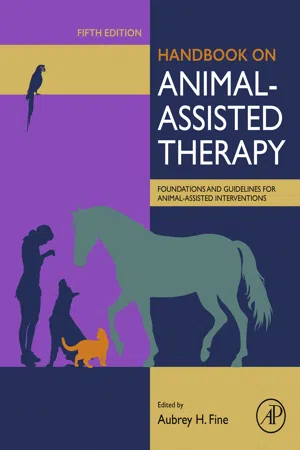
Handbook on Animal-Assisted Therapy
Foundations and Guidelines for Animal-Assisted Interventions
- 548 pages
- English
- ePUB (mobile friendly)
- Available on iOS & Android
Handbook on Animal-Assisted Therapy
Foundations and Guidelines for Animal-Assisted Interventions
About this book
Handbook on Animal-Assisted Therapy: Foundations and Guidelines for Animal-Assisted Interventions, Fifth Edition highlights advances in the field, with seven new chapters and revisions to over 75% of the material. This book will help therapists discover the benefits of incorporating animal assisted therapy into their practice, how to design and implement animal assisted interventions, and the efficacy of animal assisted therapy with different disorders and patient populations. Coverage includes the use of AAT with children, families and the elderly, in counseling and psychotherapy settings, and for treating a variety of specific disorders.- Contains seven new chapters in addition to 75% new or revised material- Includes guidelines and best practices for using animals as therapeutic companions- Addresses specific types of patients and environmental situations- Includes AAI working with cats, dogs, birds, and horses- Discusses why animals are used in therapy, as well as how
Frequently asked questions
- Essential is ideal for learners and professionals who enjoy exploring a wide range of subjects. Access the Essential Library with 800,000+ trusted titles and best-sellers across business, personal growth, and the humanities. Includes unlimited reading time and Standard Read Aloud voice.
- Complete: Perfect for advanced learners and researchers needing full, unrestricted access. Unlock 1.4M+ books across hundreds of subjects, including academic and specialized titles. The Complete Plan also includes advanced features like Premium Read Aloud and Research Assistant.
Please note we cannot support devices running on iOS 13 and Android 7 or earlier. Learn more about using the app.
Information
Incorporating Animal-Assisted Interventions Into Psychotherapy Guidelines and Suggestions for Therapists
Abstract
Keywords
14.1. Introduction
14.2. The Need for Research
Table of contents
- Cover image
- Title page
- Table of Contents
- Copyright
- Dedication
- List of Contributors
- About the Editor
- Foreword
- Preface
- Acknowledgments
- Section I. The Conceptualization of the Animal-Human Bond: The Foundation for Understanding Animal-Assisted Interventions
- Section II. Animal-Assisted Interventions and Therapy: Conceptual Model and Guidelines for Quality Assurance
- Section III. Best Practices in Animal-Assisted Therapy: Guidelines for Use of AAT With Special Populations
- Section IV. Special Topics in Animal-Assisted Interventions
- The IAHAIO Definitions for Animal Assisted Intervention and Guidelines for Wellness of Animals Involved in AAI
- Index